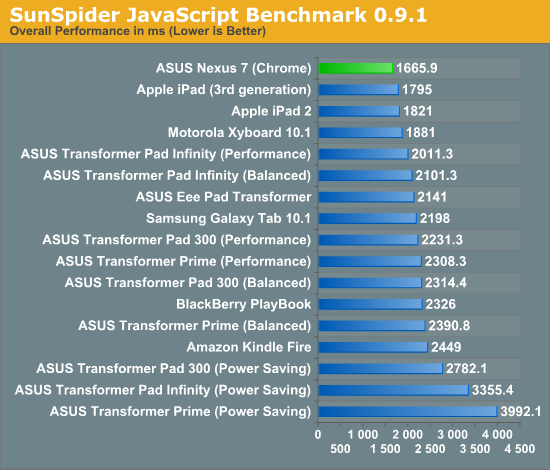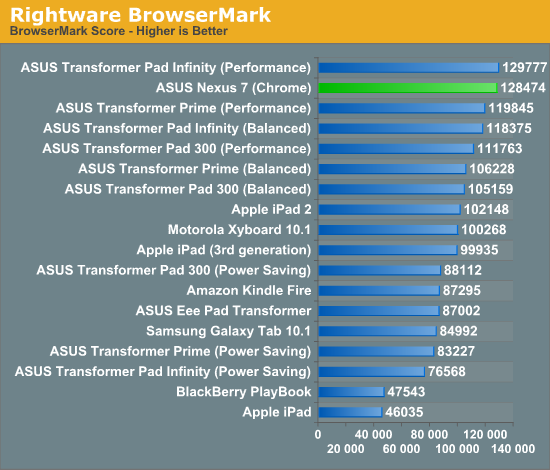The Google Nexus 7 Review
by Anand Lal Shimpi & Brian Klug on July 26, 2012 11:35 AM ESTThe SoC & Performance
While Amazon chose TI's OMAP 4 for the Kindle Fire, Google and ASUS picked arguably the second best SoC on the market today: NVIDIA's Tegra 3. Keep in mind that high-end ARM SoCs generally sell in the $14 - $25 range per chip, which a fabless semiconductor manufacturer has to split with a foundry. The result is a far cry from the margins NVIDIA is used to making on high-end discrete GPUs. I suspect a desire to make good use of all functional Tegra 3 parts that come back from the fab is the reason why we have so many variants of the Tegra 3.
To date we've seen three Tegra 3 SKUs used in tablets: T30L, T30 and T33. Factor in the smartphone SKUs (AP30, AP33) and it's already a pretty healthy collection for a single chip. The main differences between the 30L, 30 and 33 parts are voltages and clock speeds. I've shown this table in previous articles but I present it here again since T30L is what's in the Nexus 7:
| NVIDIA Tegra 3 | |||||||
| CPU Cores | Max CPU Clock (1 core active) | Max CPU Clock (multiple cores) | GPU Cores | Max GPU Clock | |||
| NVIDIA Tegra 3 (T33) | 4+1 | 1.7GHz | 1.6GHz | 12 | 520MHz | ||
| NVIDIA Tegra 3 (T30) | 4+1 | 1.4GHz | 1.3GHz | 12 | 520MHz | ||
| NVIDIA Tegra 3 (T30L) | 4+1 | 1.3GHz | 1.2GHz | 12 | 416MHz | ||
The loss in performance compared to T30/T33 is marginal at best, at least for most consumer use cases. Four Cortex A9s running at up to 1.3GHz is definitely quick enough for the types of applications you'll run on the Nexus 7. Things can always be faster, but like the Kindle Fire's OMAP 4, the Nexus 7's T30L is good enough for now. Give it another year and we'll see something even faster at this price point. That's the downside of buying anything in the tablet/smartphone space these days unfortunately.
| ASUS Android Tablet Memory Choices | ||||||
| TF Prime | TF Pad 300 | Nexus 7 | TF Pad Infinity | |||
| Memory Capacity | 1GB | 1GB | 1GB | 1GB | ||
| Memory Type | DDR2-1000 | DDR3L-1333 | DDR3L-1333 | DDR3-1600 | ||
| Memory Bandwidth | 4.0GB/s | 5.3GB/s | 5.3GB/s | 6.4GB/s | ||
ASUS selected 1GB of DDR3L-1333 memory for the Nexus 7. This gives it more memory bandwidth than any of the Transformer series of tablets, with the exception of the Transformer Pad Infinity. Since the Tegra 3 SoC only has a single channel memory interface, ASUS had to rely on higher frequency memory to deliver sufficient bandwidth.
Note that the browser performance tests below paint a very good picture for the Nexus 7's performance because Android 4.1 replaces the default web browser with Chrome, with a much faster javascript engine.













118 Comments
View All Comments
chrnochime - Thursday, July 26, 2012 - link
Great product for those who don't mind reading on a 7" screen, but for me even the 10" gets tiring after a while, though considerably less so than a 7".I am amazed at those who are able to read the tiny texts on a 7" for a prolonged period of time. Tried that with a 10" and couldn't last more than 1hr. Uh.
amdwilliam1985 - Thursday, July 26, 2012 - link
Tell that to the girls who are reading on iPhone with 3.5", I can barely see the tiny texts on their screen.Going from 3.5" to 7" will 4x their reading area, will make a heavenly difference for them.
jamyryals - Thursday, July 26, 2012 - link
What does being a girl have to do with it? I read books on my 4s quite often when traveling. Last time I checked I was a man... Yup, still am.amdwilliam1985 - Friday, July 27, 2012 - link
Sorry to bring girls into the topic.I'm only saying that because I see a lot of girls in NYC subways with iPhone 4/4S. Most guys I saw in NYC subways are with bigger phones. Just reporting my observation.
And the point of the topic is that if people can read on 3.5", then reading on 7" will be a dramatic(4x) improvement.
Akilaehunter - Thursday, July 26, 2012 - link
Every buy a paperback with uncomfortably small lettering? Or even a hardcover that tries to look artsy by using an inconvenient font?All (worthwhile) e-readers and e-reader apps allow for margin size, text size, and font style changes.
Argument is invalid; You can read a book on a 4" screen as optically comfortably as on a 10" screen, you'll just wear out your fingers flipping resized pages.
chrnochime - Thursday, July 26, 2012 - link
It's not invalid; I'd rather not have to enlarge everything and scroll a whole bunch just to read one 8" x 11" webpage.Yes I can actually see the texts all shrunken on a 7", but I have no intention to torture myself in doing so. Rather spend that time on something more productive.
Besides I *did* say it's a great device didn't I?
And not all e-readers are stuck in 7". The Amazon DX is 10" which I also have, so.
Akilaehunter - Friday, July 27, 2012 - link
Webpages, you're 100% right. I don't own a 10" tablet and even in landscape mode on a 7" many webpages can get uncomfortably small. Plus the scrolling.Still, if the nook/kindle app is uncomfortable to read books with it's one's own fault for not making it comfortable with the many combinations of size options.
CeriseCogburn - Sunday, July 29, 2012 - link
It's never comfortable as the screen needs to be closer so the eye fry syndrome overtakes any blurry eyed goon who can't read small text.I suspect a far sighted elderly person with bifocals can hold it at arms length and "telescope" in to the text, but then, have never seen that.
Next we'll have a flurry of articles analyzing peeps with facial skin cancer then we'll have the scare articles that quote the hidden study.
In the mean time the tiny teens and teeny texts can increase corporate visine profit margins.
They should call these devices "fryballs!"
Super56K - Monday, July 30, 2012 - link
Yes, because before e-readers/tablets all the books I purchased were 10" + in physical size, and I had to hold mass market paperbacks 5" away from my face to read the tiny words. You're a feisty one Cogburn.Akilaehunter - Thursday, July 26, 2012 - link
First off, this is my first article response, though I've been lurking since 2004.A nitpick to start things off: I know this site tests a ton of mobile hardware so why are some models shown for some tests in an article and not others -in the same article- as comparisons? For instance, my Droid Razr Maxx is in a few comparisons (not this article) but not all. Should maybe be a database cataloguing them all, ala the gfx card benches section? (Or if there is I'm too dense to see it...)
Otherwise, excellent article as always. Especially interested in how the flash storage is the main bottleneck now. Tegra 3 could be a beast at multitasking if all its cores are accounted for, but would then get strangled by IO as soon as it is told to multitask- something a multi-core cpu should be amazing at.
Lot to think about. :D